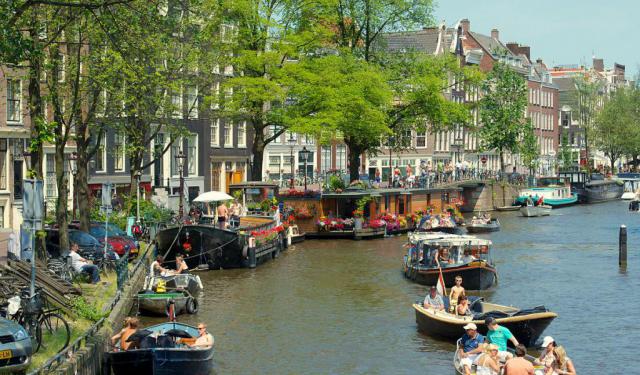
Dutch Sweets and Pastries
Known primarily for their cheeses, the Dutch have proven just as passionate about their sweets and pastries, many of which have come about as a result of the centuries of colonial past that had infused Holland with Oriental flavors and ingredients. Blended with their own dairy-rich European tradition, the Dutch now have the pleasure of indulging in the best of the sweet-making cultures, once worlds apart, on their home turf. To figure out which of the Dutch desserts are particularly worthy, follow this guide and see for yourself!
(To visit the venues mentioned in this article, check out these Self-Guided Walking Tours in Amsterdam)
1. Oliebollen
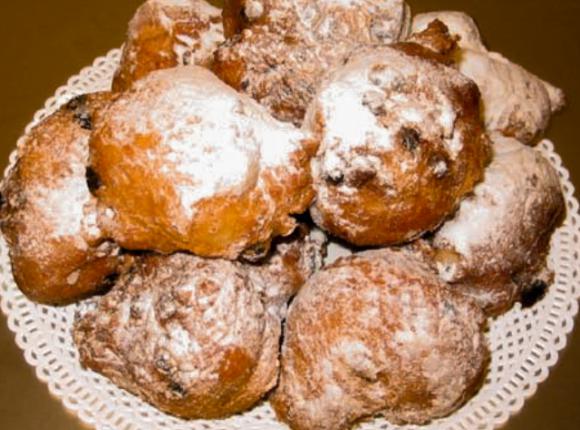
Image Courtesy of: Takeaway
Quite similar to the American donuts, Dutch-made olibolen (“oil balls”) dumplings have been known for centuries as a prominent part of the Dutch cuisine. Today, these deep-fried dough balls serve as a traditional snack served for Christmas and New Year. Unlike donuts though, their doughiness is enhanced with pieces of apple or raisins (sultanas) or some other dried fruit (currants, pieces of orange), sometimes lemon zest or succade (candied fruit) or whipped cream are also added, plus an obligatory cover with plenty of sugar icing or powder. Oliebollen are rather easy to make – a scoop or two of dough (made of eggs, yeast, salt, flour, milk and baking powder) dropped into a deep fryer full of hot oil, and that's it. To make the best of your oliebollen, try and eat them either fresh hot from the fryer, or cold, with a cup of coffee.
2. Appeltaart
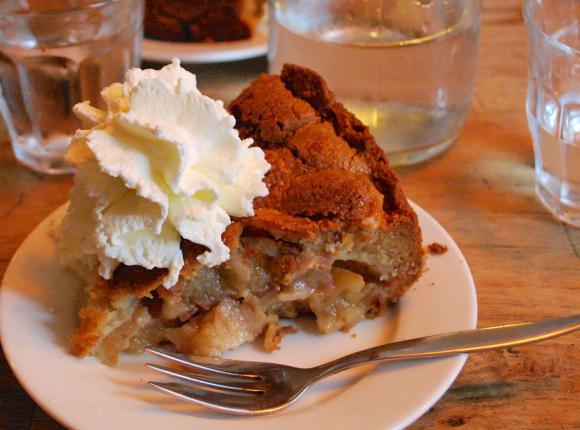
Image Courtesy of: Marco Metzler
Appeltaart, a traditional Dutch apple pie, classic of all the Dutch delicacies, is nothing like an American apple pie or French apple tart, or even the Dutch apple pies found outside the Netherlands. The locals pack it with massive chunks of caramelised apples flavored with Speculaaskruiden (speculaas spices incl. cinnamon, clove, ginger, cardamom, anise, etc.), plus sugar and lemon juice, as well as, sometimes, raisins, currants and almond paste; and top it all off with a lattice of crumbly, breaded pastry strips. The pie boasts a thick, cake-like crust, with bottom and edges made of sweet cakey dough. The sorts of apple used for appeltaart are Elstar, Gala and Goudreinet, as they are crispy and not so sweet. This chewy buttery pie, tender yet crunchy, literally melts in your mouth, and is commonly served with a dollop of met slagroom (thick Dutch-style whipped cream) or vanilla ice cream, and a cup of coffee.
3. Tompouce
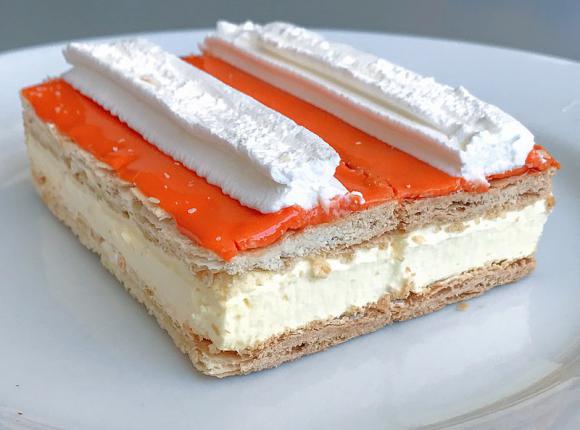
Image Courtesy of: Amin
Reportedly named after a performing dwarf who went by his stage name Tom Pouce, these delicious, rectangular, sandwich-like puff pastries are similar to French mille-feuille (aka Napoleon), but with considerably more vanilla custard filling. Strictly regulated in terms of size, shape and color, tompouce is characterised by a layer of smooth pink, occasionally white, glaze on top, which for one day a year only, the Koningsdag (King’s Day), is allowed to become orange in honor of the Dutch royal Orange-Nassau family. Starting circa 1990, the color is also allowed to become orange whenever Holland play at major international football tournaments. As regards the filling, it is invariably sweet and yellow cream. On some occasions, tompouces may be topped with whipped cream as well. Usually served with tea or coffee, the cakes are extremely brittle and prone to a bit of a mess, even if eaten with a fork. For a more convenient and perhaps less dignified way of eating them, the frosted top layer is recommended being taken off with one hand, and the bottom held with the other, followed by consecutive bites to each part. But even then, there's still a risk of having the whipped cream squashed onto your hand, so extra caution is well due.
4. Bossche Bollen
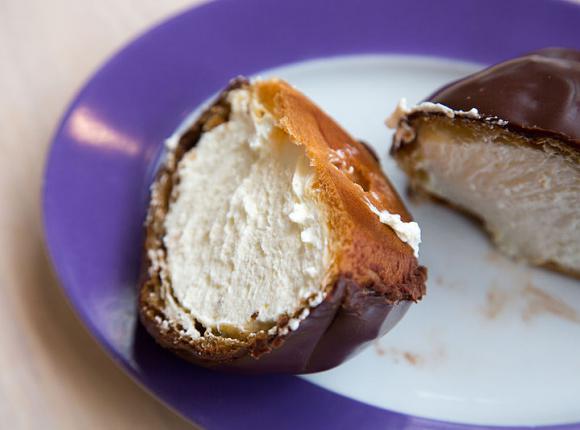
Image Courtesy of: Norio NAKAYAMA
Inspired by French profiteroles (cream puffs), these cakes from the Dutch city of Den Bosch – hence Bossche bollen (“Bosch balls”) – are, in essence, pastries the size of a tennis ball, or slightly bigger (approximately 12 cm/5 in. in diameter), covered in glossy, usually dark, crunchy chocolate. This is why the locals commonly refer to them as sjekladebollen ("chocolate balls"). The pastries are filled with whipped cream and look like someone has taken all the best of an eclair au chocolat, stuffed it into a ball, and then drowned it in rich chocolate. Seemingly invented for a sticky-finger enjoyment, Bossche bollen usually cause quite a mess, when eaten, as the Dutch tend to eat them deliberately without any cutlery, holding the pastries upside down, so as to prevent the cream from spilling out. Bossche bollen are usually taken with coffee.
5. Spekkoek
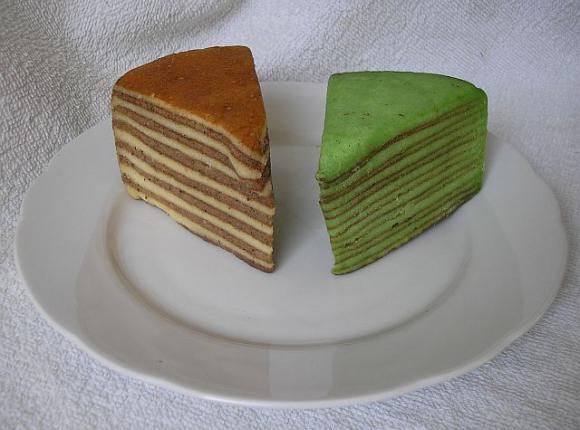
Image Courtesy of: Pudding4brains
A delicious legacy of Holland's East Indian colonial past, spekkoek – a traditional Indonesian multi-layered spiced cake – manifests a harmonious blend of Eastern and Western culinary traditions. Created in Indonesia, this cake abounds in spices, native to the country of origin (cardamon, cinnamon, clove, mace and anise), and is notoriously difficult to make because of the large number of thin layers involved. Made of flour, yolk, and rich in butter or margarine, spekkoek, albeit spit cake in essence, is not baked on a rotating spit. The name spekkoek translates literally to "pork belly" or "bacon cake", and is due to its resemblance to the dark and light layers of bacon. In Indonesia, they call it lapis legit which means "sweet layer cake."
6. Vlaai
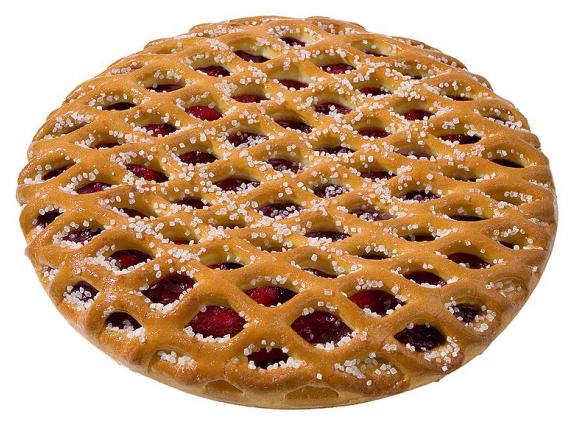
Image Courtesy of: Vlario
Also known as Limburgse Vlaai for its origin in the Limburg province of the Netherlands and Belgium, or Weertervlaai, in honor of the town of Weert where the current standard version of Dutch vlaai was created, the traditional Vlaai pie (tart) measures about 30 centimeters in diameter, and consists of pastry and, usually, fruit filling (apricots, plums, strawberries or cherries). Occasionally, it may also contain crumbled butter and sugar mix ("greumellevlaai" in Limburgish, or "kruimelvlaai" in Dutch) or cooked rice and custard porridge ("rijstevlaai"). A properly baked Vlaai boasts chewy, in the right way, crust and is usually topped with large grains of crunchy sugar. Most often it is eaten on very special occasions, such as birthdays or funerals.
7. Vla Custard
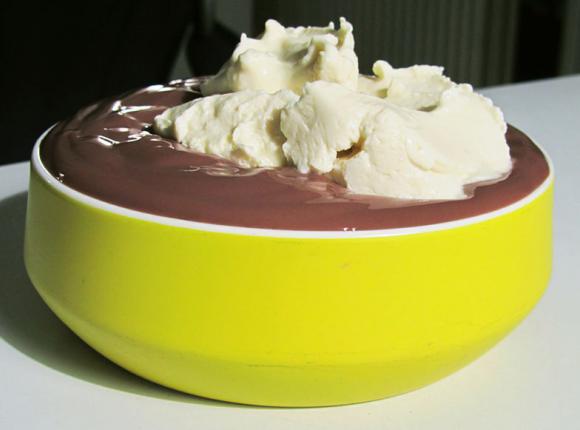
Image Courtesy of: Oscar
Albeit similar, in many ways, to the English custard, Vla is considered a standalone dessert rather than a sweet ingredient. Also, unlike custard, it is consumed cold and comes in a variety of flavours: chocolate, vanilla, strawberry, caramel, banana, orange or apple. Traditionally, vla is made with eggs, sugar and fresh milk, although today, some industrial manufacturers tend to replace eggs with cornstarch. Oftentimes, the Dutch treat themselves to a concoction of two or more of vla flavours, topped off with a massive dollop of whipped cream and sprinkles.
8. Ontbijtkoek

Image Courtesy of: Takeaway
Ontbijtkoek ("breakfast cake") or peperkoek ("pepper cake") is what they call this spiced cake in Dutch and Flemish respectively. Originally, the cake was made from breadcrumbs and other bakery leftovers which were periodically collected and pressed, and then augmented with black pepper - one of the most valuable trading products of the Dutch East India Company of the time, so as to conceal the age of bread; hence the name - "pepper cake". Today, they put in a whole bunch of other spices as well, including clove, cinnamon, ginger, succade, aniseed, and nutmeg. Rye is the most important ingredient however, which gives the cake its light brown color. The delicious cake comes in loaves, and is stodgy enough, so one slice is usually enough. For utter enjoyment, they recommend spreading a slice with a generous load of butter.
9. Pepernoten

Image Courtesy of: M.Minderhoud
Pepernoten ("pepper nuts") are light brown, randomly-shaped (usually squarish), thick, penny-sized cookie-like snacks, of Dutch/Belgian origin, that come in season early December, in time for Sinterklaas holiday. The ingredients are very similar to those speculaas (“windmill cookies”) are made of and include anise, cardomon, clove, cinnamon, pepper, butter, vinegar, eggs, brown syrup, and rye flour. Pepernoten are commonly served covered in either chocolate or marzipan. Fairly chewy at the beginning, they tend to harden a bit eventually, if left in the open air, and become crunchy. The latter, complete with a pronounced tang, is what ultimately makes pepernoten different from speculaas.
10. Kerststol/ Paasbrood
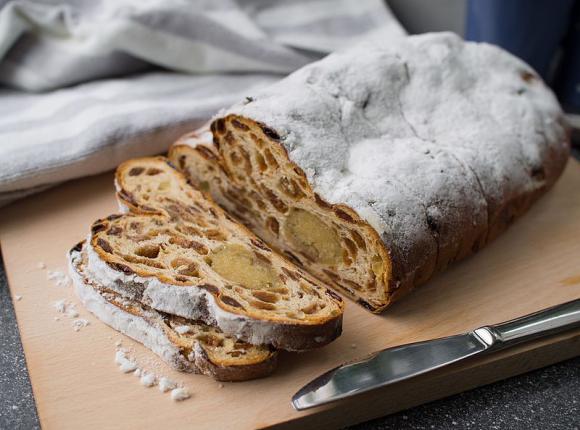
Image Courtesy of: Takeaway
Kerststol is a traditional Dutch sweet Christmas bread, oval-shaped, much like Paasbrood (Easter bread), but with powdered sugar on top. It is yeast-based and contains, among other key ingredients, dried fruits, sultanas, raisins, currants, lemon and orange zest, water, milk, butter, sugar, vanilla, brandy and cinnamon. On top of that, the more luxurious varieties may include chopped walnuts, almonds, or hazelnuts, as well as ginger powder or grated crystallized ginger, dried cherries and cranberries, apple, kiwi or cardamom added to the dough. The latter, upon resting, is filled with a log (large chunks) of amandelspijs ("almond paste") placed in the middle, with the dough then folded over it lengthways and sealed with gentle pinches. Afterwards, the mixture is rolled over a slab of marzipan and baked until the outer crust gets crispy and brown, while the inside remains soft and fluffy, and deliciously gooey. When ready, the cake is dusted with sugar powder, thickly sliced, and eaten with butter spread over the slices, washed down with some seasonal beer or wine.
11. Duivekater

Image Courtesy of: Peterensimon
Duivekater is a traditional Easter bread (sometimes served at Christmas, too), lightly sweetened – a somewhat forgotten delicacy first baked in Amsterdam. Luxury food as such, this white bread is rich in milk and butter, and has lemon zest added for a distinctive aroma. It is more compact than brioche, with only tiny air bubbles in it. The name Duivekater, also spelled "deuvekater," refers neither to duif ("doves") nor kater ("cats"), but translates directly to “devil’s cake,” which is rooted in the old tradition of sacrificing animals to the gods at Easter, later replaced by sacrificing just one limb of an animal, and ultimately a bread in the form of a limb. The Dutch prefer eating it sliced, with some butter on it. After a few days, the flavor is said to become even better and remains so for about a week.
12. Gevulde Koek
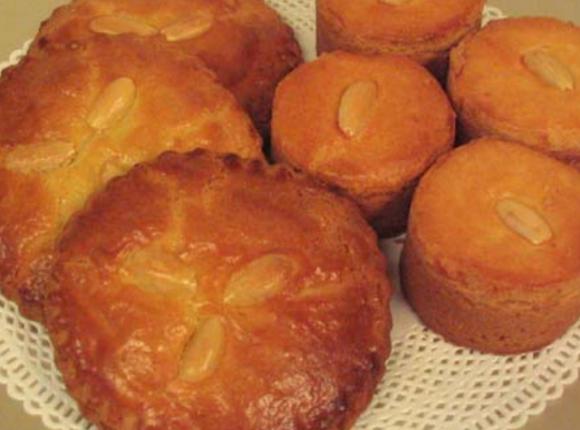
Image Courtesy of: Teunie
A gevulde koek, or " almond cookie," is a large (about 10 cm in diameter), round butter cookie laden with a sweet, most commonly almond paste, filling in the center. It is traditionally adorned with a horizontally halved almond on top. A perfect example of typical Dutch baking; a truly tasty cookie – ideal treat to pair with a cup of bitter afternoon coffee, tea or hot chocolate.
13. Boterkoek
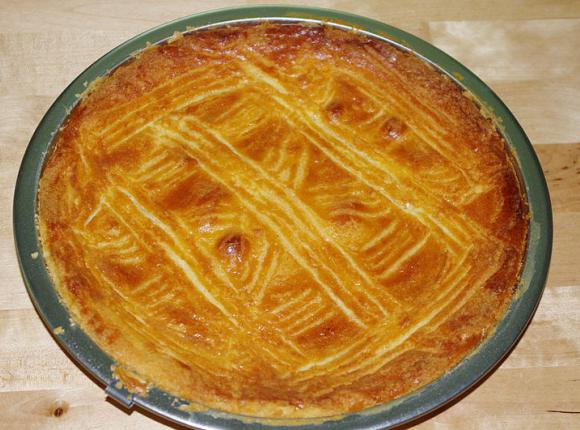
Image Courtesy of: JZ85
Boterkoek ("butter cake") is rich in calories, which is no wonder, considering it consists of hardly anything but butter, caster sugar, flour, and eggs. Also, for a bit of flavor, they add lemon zest, salt and vanilla. This delicious cake is dense and sweet, much as it's creamy (if not say, buttery), crumbly and smooth, and it surely does stick well to one's ribs. A small piece of it will suffice to please a sweet tooth and to keep one going for many miles. Usually served with a steaming cup of coffee, this simple recipe delicacy is a true showcase of the goodness of the dairy richness the Netherlands is famous for.
14. Dutch letter
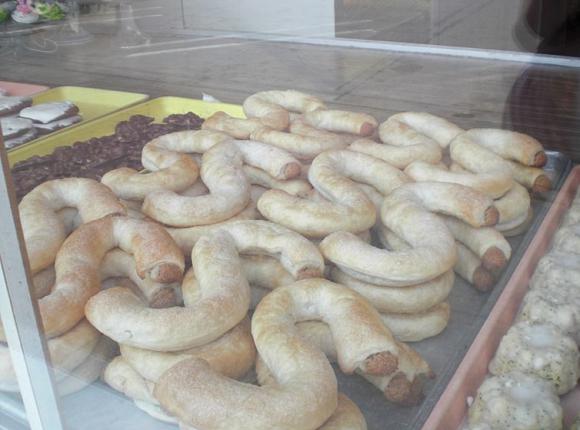
Image Courtesy of: heather vescent
A Dutch letter pastry, otherwise known as a banket-, almond- or butter letter (banketstaven, letterbanket) is a variation of chocolate letter sweets. Just as the latter, these pastries originally were shaped in the form of the recepient's surname's initial or the first names of the family members. Today, they are most commonly shaped as "S", "O", or "M". These pastries are porous, airy and flaky in texture and are typically made of flour, eggs and butter, filled with almond paste (a mixture of almond meal and honey or sugar), and dusted with sugar powder. Traditionally, the letters are eaten on the Sinterklaasavond holiday, December 5.
15. Kruidnoten
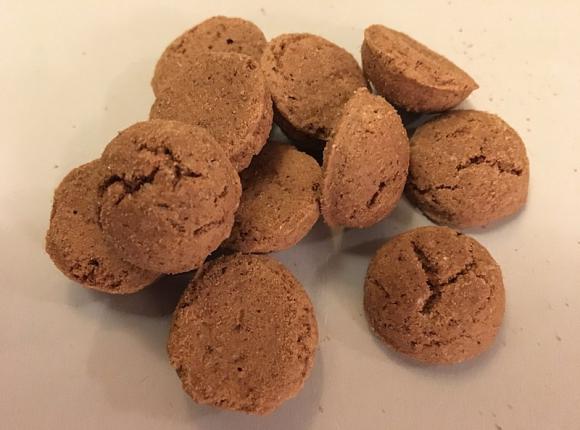
Image Courtesy of: Hanno Lans
Kruidnoten ("spice nuts") are small, round and somewhat hard, cookie-like confectioneries with a crispy texture, of different color and shape, and made of the same ingredients as the speculaas cookies. They also vary in terms of coverings, from chocolate truffle (white, milk, or plain) to caramel-covered kruidnoten and more. Crunchy and spicy, kruidnoten (not to be confused with pepernoten!) are traditionally associated with the Sinterklaas festivities held in early December.
Get GPSmyCity App for IOS or Android
You can read offline thousands of travel articles like this one in the "GPSmyCity: Walks in 1K+ Cities" app on Apple App Store or Google Play Store. The apps also offer city offline maps and GPS navigation to guide you to the places featured in the articles.
Walking Tours in Amsterdam, Netherlands
Create Your Own Walk in Amsterdam
Creating your own self-guided walk in Amsterdam is easy and fun. Choose the city attractions that you want to see and a walk route map will be created just for you. You can even set your hotel as the start point of the walk.
Jordaan Walking Tour
The Jordaan district of Amsterdam is a popular neighborhood renowned for its charming, narrow streets, quaint courtyards, and picturesque canals. Replete with beautiful historic houses, many of which have been converted into cozy cafés, trendy boutiques, and art galleries, this district has a distinctive atmosphere that sets it apart from other areas in the city.
The Jordaan was originally... view more
Tour Duration: 1 Hour(s)
Travel Distance: 2.4 Km or 1.5 Miles
The Jordaan was originally... view more
Tour Duration: 1 Hour(s)
Travel Distance: 2.4 Km or 1.5 Miles
Jewish Quarter Walking Tour
Welcome to Amsterdam’s Jewish Quarter, a neighborhood rich in history, tracing the ebb and flow of the city’s Jewish community. It all began in the late 16th and early 17th centuries, when Sephardic Jews fleeing persecution in Spain and Portugal found refuge here. With its relatively tolerant atmosphere, Amsterdam quickly became a sanctuary, and before long, Ashkenazi Jews from Central and... view more
Tour Duration: 2 Hour(s)
Travel Distance: 2.3 Km or 1.4 Miles
Tour Duration: 2 Hour(s)
Travel Distance: 2.3 Km or 1.4 Miles
Amsterdam Introduction Walking Tour
The Dutch capital, Amsterdam, some say, “dances to its own beat.” Indeed, Amsterdam – where “hipness meets history” – has a rather unusual life rhythm and style, famously manifested in the air of legalized cannabis, coffee shops, and the Red Light District. In large part, this “air of freedom” attracts annually to the city over five million visitors.
As a small fishing village,... view more
Tour Duration: 2 Hour(s)
Travel Distance: 4.0 Km or 2.5 Miles
As a small fishing village,... view more
Tour Duration: 2 Hour(s)
Travel Distance: 4.0 Km or 2.5 Miles

